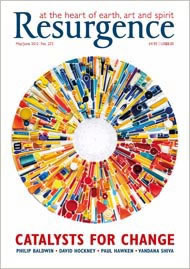This is a wonderful book! I am boldly stating this at the beginning since I recently read a review where, frustratingly, it took several hundred words before the author gave any assessment at all of the book in question. Gardening as a Sacred Art is not only a masterful summary of the history of gardens (from antiquity to the early 20th century) from the spiritual perspective but, more importantly, it culminates in a beautiful meditation upon how the gardener may steer the garden “towards becoming an icon”, an image, as William Robinson wrote, “not only fair in form and lovely in colour, but in its breath and essence coming from the Divine”. Thus the main thrust of this profound and inspiring volume is to remind us that gardens are essentially sacred spaces in which we may work together with Nature in order that we may help her – and ourselves in the process – express more fully the divine presence hidden within the heart of her outward beauty.
The great Sufi authority Martin Lings writes that there is no traditional doctrine “that does not teach that this world is a world of symbols”. It is this perspective, of the whole of the sensory world being a symbol or a reflection of a higher reality, that Jeremy Naydler is putting forward – or rather reviving – especially in the last two chapters.
In the last chapter, he clearly explains the medieval concept of Natura naturans and Natura naturata, the first being the invisible world of the spirit and the second being the visible world of phenomena. He reminds us that when gardening we need to remember who we are in relation to Nature. We need to endeavour to “be a collaborator in a greater creative process”, be attuned to the spirit of the place and work in harmony with it: “And so the garden, as a work of art, results from a dialogue between the gardener and the spirit.” By way of an illustration of this, the author writes poetically and movingly about Monet’s garden at Giverny, where “the profusion of beauty seemed to be held in a magical atmosphere” and where the artist was attempting “to sink himself ever-more deeply into the phenomenal world, to penetrate nature’s creativity through his own creative activity”, striving “to arrive at the very source of beauty”.
Anyone who is already familiar with Jeremy Naydler’s work on what might loosely be called the philosophy of gardening will have high expectations of this book – and they will not be disappointed. His essays on Perceptions of the Divine in Nature, including The Heart of the Lily, are gems of profound observation and research; and his small book of poems, Soul Gardening (Godstow Press), is reflective, charming and humorous.
He is, there is no doubt, the best person to write on gardening as a sacred art, since not only is he a well-established philosopher, holding a doctorate in theology and religious studies, but, crucially, a practitioner of the art and craft of gardening (see Jeremy’s own article on page 31). What he succeeds in doing is to relate the practice to the metaphysics, in a remarkable and sensitive way that may only be achieved from long experience of working with the soil, the plants, the trees – becoming one with the atmosphere and the ‘spirit of the place’. The picture of one of his ‘own’ gardens is testimony to this, although I must add that a better photograph would have done this garden greater justice!
As our disconnection with Nature is ever more apparent (80% of the world’s population will be living in cities by 2020, as predicted on the BBC recently) and our times become increasingly secularised, the challenge, as the author writes in his last paragraph, is “to find the way to re-sacralise our work as gardeners”. Refreshingly, he does not dwell on what appears to be a pretty bleak outlook, but reminds us that if we make an effort and not only become more aware that the manifest world holds hidden spiritual truths but also become “creatively engaged with this inward dimension of Nature” then we may “open a window onto the spirit” and let the divine back into our world.
Emma Clark is leading a weekend introductory course on sacred gardens in September 2012. For more details please email: [email protected] or visit: www.emma-clark.com
Emma Clark is a garden designer, writer and lecturer specialising in Islamic gardens. She teaches at The Prince’s School of Traditional Arts, London and is the author of The Art of the Islamic Garden (Crowood).







